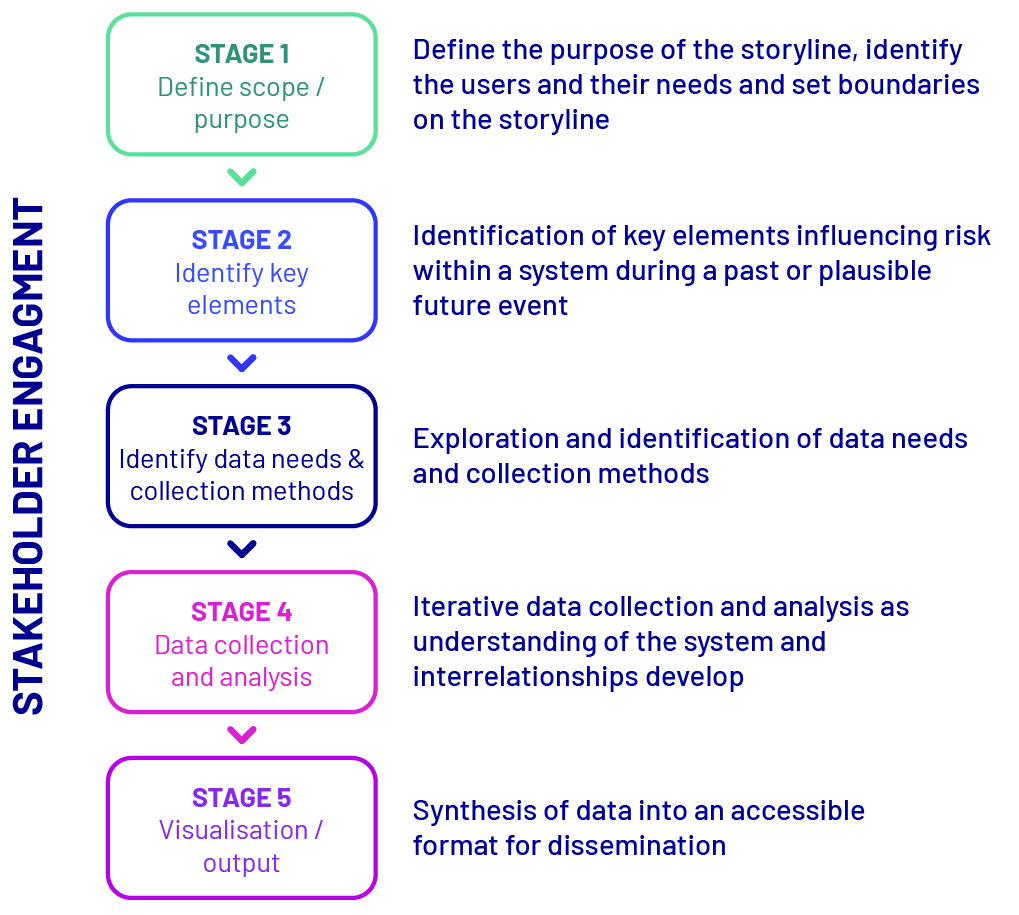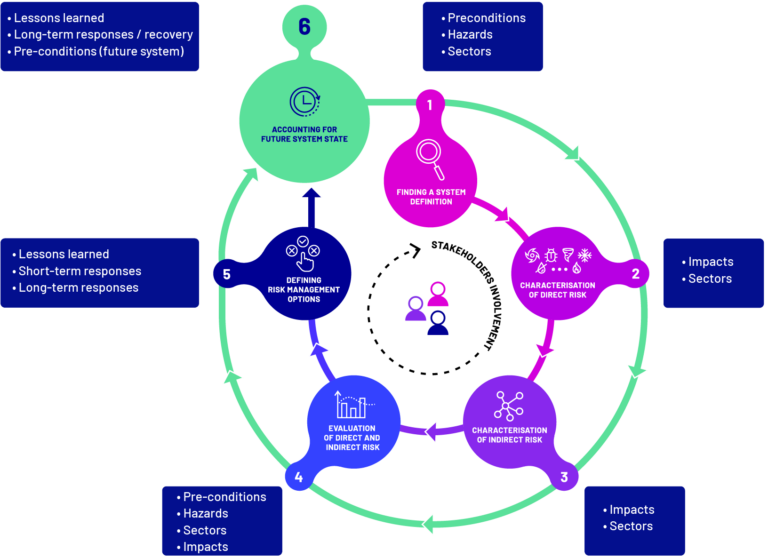Storylines to support multi-risk decision-making
SUMMARY
Multi-risk storylines use narratives of past or plausible future events to explore and characterise cause-and-effect relationships between risk drivers and impacts within a system. Storylines can be purely qualitative or include semi- or fully quantitative components enabling a holistic examination of a system that can account for non-quantifiable elements and high levels of uncertainties. Storylines can be used to understand why a system responded in a particular way to an event and explore how changing elements within a system could change the outcome. This can include how decisions made can impact the system and the unfolding of events.
Storylines pay attention to plausibility rather than probability: the focus is on the understanding of driving factors and the societal response. Past events are often used as a basis for storyline development, as they assure a credible justification for the selection of events and provide highly relevant context for the already experienced risks.
MYRIAD-EU has developed and applied a storyline approach to break down the complexity and examine the interacting nature of multi-risk systems through analysis of past or plausible future events with the aim of informing disaster risk management planning.
The storylines approach is being used by MYRIAD-EU Pilot teams to:
- support their understanding of the complexities of multi-hazard, multi-risk events in their regions;
-
facilitate cross-sectoral engagement with stakeholders on multi-hazard, multi-risk decision-making;
-
facilitate communication of complex relationships to raise awareness of multi-risk events;
- support drafting of forward-looking decision-making pathways for plausible future events.
STORYLINE APPROACH

The MYRIAD storyline approach follows five stages involving defining the purpose of the storyline and setting boundaries (Stage 1), identifying key multi-risk elements for exploration (Stage 2), identifying data needs and methods of data collection (Stage 3), data collection and analysis (Stage 4), and synthesis into a final output (Stage 5). The MYRIAD-EU storylines are visualised using the tool Esri ArcGIS StoryMaps accessible in the online repository.
RELATIONSHIP TO THE MYRIAD-EU FRAMEWORK
Storylines can be used to support implementation of the steps of the MYRIAD-EU framework by offering a holistic approach that helps to:
- define and visualise the system (step 1 of the framework)
- characterise and evaluate direct and indirect impacts, which can be used to inform direct and indirect risk (steps 2 – 4)
- identify risk management strategies (step 5)
- account for future system state (step 6).
Many of the guidance protocol questions outlined in the framework are applied in the storylines approach.

At the heart of the storylines approach is stakeholder engagement, and the use of narratives to explore key elements of the systemic multi-risk paradigm. Stakeholder engagement can occur at any stage of the storyline development process, resulting in direct and indirect advantages of knowledge co-development.
STEP 1 – Finding a system definition
The storylines approach offers a way of defining the system through the exploration of three key elements:
- Pre-conditions or state: geographic and environmental factors, exposure and vulnerability, as well as governance and policies
- Hazards: hazards and multi-hazard relationships that affect or could affect the system (if the storyline focuses on past or plausible future multi-hazard events, respectively)
- Sectors: the economic sectors that were affected or have the potential to be affected by a multi-hazard event
Before characterisation of these elements, the first stage is to define the purpose and scope of the storyline and identify users and their needs. Temporal and spatial boundaries can also be set. This is important for guiding the focused development of the storyline while still enabling the exploration of the complexities within multi-risk systems.
STEP 2 – Characterisation of direct risk
- Hazards
- Sectors: sectoral dependencies, cross-sectoral planning, etc.
- Impacts: those directly resulting from the hazard event itself
- Exposure and vulnerability: characterised through exploration of the pre-conditions or system state
Storylines applied in MYRIAD-EU offer a more qualitative approach to defining and characterising direct risk. However, more quantitative approaches can be integrated, such as the MYRIAD-EU software for simulating multi-hazard and multi-risk scenarios across Europe and tools for investigating multi-risk dynamics.
STEP 3 – Characterisation of indirect risk
Building on the system definition and exploration of direct risk, indirect risk can be explored within the storyline approach through the consideration of:
- Hazards
- Sectors: sectoral dependencies, cross-sectoral planning, etc.
- Impacts: those linked but not directly caused by the hazards themselves
- Exposure and vulnerability: characterised through exploration of the pre-conditions or system state
The MYRIAD-EU multi-risk storylines offers a qualitative approach to defining and characterising indirect risk. However, more quantitative approaches can be integrated, such as the general model for evaluating indirect losses included in MYRIAD-EU software for simulating multi-hazard and multi-risk scenarios across Europe.
STEP 4 – Evaluation of direct and indirect risk
Storylines could support the development of risk criteria for the evaluation of direct and indirect risk by integrating diverse perspectives through participatory approaches, such as stakeholder workshops, interviews, or expert elicitation. These can aim towards co-defining and refinement of risk criteria, embedding social and economic dimensions into the evaluation, or facilitating trade-off analysis (via scenario-based evaluations).
Similarly, storylines can integrate more quantitative approaches supporting the evaluation of direct and indirect risk including methods developed in the MYRIAD-EU software.
STEP 5 – Defining risk management options
The MYRIAD-EU multi-risk storylines offer users the opportunity to explore both past and plausible future multi-risk events. This enables them to inform the decision-making process through consideration of:
- Short-term responses: emergency responses immediately following an event; mitigation measures taken to limit the impacts of an event; responsibilities and coordination of short-term responses, as well as any underlying assumptions that may influence responses.
- Long-term responses/recovery: actions that provide longer-term solutions and protections beyond the short-term emergency responses such as installing early-warning systems; the shift from response to recovery.
STEP 6 – Accounting for future system state
The MYRIAD-EU multi-risk storyline approach offers the ability to reflect on any lessons learned from the decision-making process during past events, as well as the temporal, spatial or causal relationships between any risk drivers and impacts within a system. It is also an opportunity to reflect on what went well and why, as well as what could have been done better. This can also be applied for consideration of plausible future events, anticipating potential lessons from future decision-making processes in response to plausible risk scenarios.
The storylines approach has been used by MYRIAD-EU Pilots to support the development of initial forward-looking decision-making pathways for plausible future events through the qualitative exploration of the key elements of multi-risk events.
